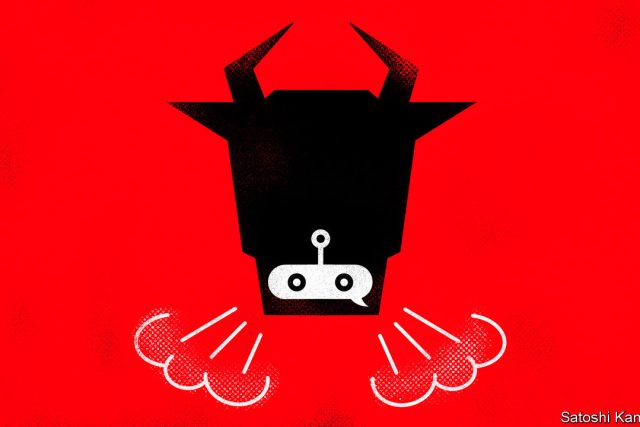Do you buy the hype? The release of Chatgpt, a tool designed by OpenAI, has kicked off a wave of enthusiasm about artificial intelligence (ai). Everyone from spy agencies to law firms is trying to make use of the technology. And investors are working out how they might be able to take advantage of this by buying ai-exposed firms.
In the stockmarket this has manifested itself as an almighty boom in the valuation of tech companies. Openai might be private, but more than a dozen firms that design ai software, have invented or build the computing chips that make ai possible, or run the data centres that the tech relies on are included in the s&p 500 index of leading American shares. The latest firm to experience an ai-induced rally is Nvidia. The Californian company’s share price has risen by almost 40% since it reported unexpectedly strong earnings on May 24th, and has almost tripled in the year to date. Nvidia is now the fifth most-valuable listed corporate entity in America.
Yet it is not just tech firms that are thriving. The ai boom has coincided with a broader recovery in stockmarkets, which were battered last year by a combination of high inflation and rising rates. The s&p 500 is up by 8% since Chatgpt was launched, and has risen almost 20% from its October low. This prompts a question. Just how much of the rally is explained by ai enthusiasm?
To answer such a question, it is necessary first to rule out the usual culprits for major market moves: namely, shifting interest-rate or growth expectations. After all, owning a share is ultimately a claim on the future earnings of a firm. One way of working out the value of a share today is by estimating future earnings, and potential growth, before applying a discount or interest rate to calculate their value. This time around a shifting macro outlook cannot illuminate market movements. In November investors thought the federal-funds rate would rise to around 5-5.5% by the end of 2023. Although sentiment has oscillated, it has settled at about the same place. An average of earnings expectations for the year is also where it was six months ago.
The next step is more straightforward: it involves quantifying the size of the ai bounce. Analysts reckon that the s&p 500 has 14 firms with significant exposure to the tech. These include both well-known giants, such as Google and Microsoft, and lesser-known providers of underlying infrastructure, like Arista and NetApp, two data-centre companies. On its own, the price of Nvidia is responsible for an enormous slice of the stockmarket recovery. Since the end of November the firm’s market capitalisation has soared from under $400bn to $950bn—accounting for a fifth of the rally. Add Nvidia’s surge to the growing market capitalisations of the 13 other firms with ai exposure and a remarkable 73% of the broader rally is explained. The boom in ai tech stocks has comfortably outstripped the wider tech rally. The nasdaq is up by a fifth since November, compared with a third for the most ai-exposed firms.
That ai optimism is the driver of the recent rally becomes even clearer when looking at share price “multiples”, which divide current prices by current or future earnings. These multiples are affected by earnings and economic factors like interest rates, but also more nebulous things under the broad label of “animal spirits”. In November the average price to current earnings multiple of an s&p 500 firm, excluding the 14 most exposed to ai, was around 27. As we went to press, the multiple had dipped to 26. Meanwhile, the average multiple of firms in our ai bucket had leapt from 43 to 77.
These multiples might be justified. Much of the excitement about Nvidia’s prospects has been prompted by orders for the company’s chips. During the firm’s earnings call representatives suggested that income from data-centre chips was on track to double, from an already record-breaking $4bn in the first quarter to $8bn in the second.
On the other hand, investors have been known to get over-excited about novel technologies. The internet made a new generation of companies (and their bumper profits) possible. It set off a wave of productivity improvements for economies around the world. The problem is that much of this happened after a stockmarket bubble, which caused speculators to lose their shirts. It is obvious that investors making bets on ai must assess whether the hype is justified this time around. But such is the importance of ai to the broader stockmarket, so must everyone else, too. ■




The Most Read
Сryptocurrencies
Bitcoin and Altcoins Trading Near Make-or-Break Levels
Financial crimes
Thieves targeted crypto execs and threatened their families in wide-ranging scheme
Financial crimes
Visa Warning: Hackers Ramp Up Card Stealing Attacks At Gas Stations
News
Capitalism is having an identity crisis – but it is still the best system
Uncategorized
The 73-year-old Vietnamese refugee is responsible for bringing Sriracha to American consumers
Uncategorized
Electric Truckmaker Rivian, Backed By Amazon, Ford, Raises Whopping $1.3 Billion